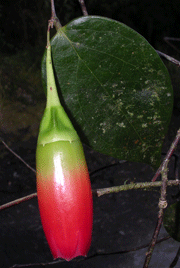James L. Luteyn and Paola Pedraza-Peñalosa
The New York Botanical Garden
|
|
Semiramsia is a genus of four species of terrestrial or epiphytic shrubs
found in premontane to montane habitats in Venezuela, Colombia, Ecuador,
and northern Peru. One species is endemic to the Coastal Range of
Venezuela, two are endemic to southern Colombia, and the fourth is rare,
but widespread from southern Colombia to southern Peru. The genus
is characterized by very large and sympetalous flowers which broaden distally,
corolla lobes short and broad, inferior ovaries, calyces continuous with
the pedicels, tubules very narrow and much longer than the thecae, thecae
strongly papillose, dehiscence by short, oval oblique clefts or perfectly
terminal pores, and berry fruits. The relationships of Semiramisia lie with Ceratostema Juss. The two genera have in common very
large corollas and almost identical stamens. The differences between
them are primarily that Ceratostema has its calyx articulate with
the pedicel, a corolla usually conspicuously broadened or swollen basally,
and corollas with very long and narrow, deep lobes (see table in Luteyn,
1984). J. F. Klotzsch (1851) named and described Semiramisia, after Semiramis (ca. 800 B.C.), an Assyrian princess. He recognized two species in the genus. Hooker (1876) maintained the genus and suggested a relationship with Psammisia. Niedenzu (1890) suggested a relationship with Ceratostema and Drude (1891) with Thibuadia. Between 1932 and 1984 five additional species were described in the genus (see Smith 1933a, 1943b, 1952; Sleumer 1941; and Luteyn, 1984), although not all are herein recognized. As a whole, Semiramisia, must be considered in extreme danger of extinction for the localities and habitats in which they have been found are all undergoing severe alteration. |
SEMIRAMISIA Klotzsch, Linnaea 24: 25. 1851. Type: Semiramisia speciosa (Benth.) Klotzsch.
Terrestrial or epiphytic shrubs, rarely lianoid. Leaves alternate, petiolate, coricaeous, ovate-lanceolate, acuminate, margin entire, glabrous but with scattered glandular fimbriae beneath, plinerved. Inflorescence axillary, short-racemose or flowers solitary; floral bracts inconspicuous; pedicels bibracteolate. Flowers 5-merous, without odor; aestivation valvate; calyx continuous with the pedicel; hypanthium obconical, terete to angled or winged (the angles or wings alternating with the lobes); lobes apiculate; corolla terete, broadening distally, fleshy when fresh but drying membranous, shallowly lobed, bistratose between the lobes, the lobes short and broad; stamens 10, equal with each other, slightly shorter than the corolla; filaments connate or distinct, shorter than anthers, lacking spurs; anthers lacking disintegration tissue; thecae strongly granular; tubules elongate, about one-half as broad as the thecae, dehiscing by terminal or subterminal oblique, sometimes flaring pores; pollen lacking viscin threads; ovary inferior, 5-locular, glabrous; style nearly equalling the corolla. Fruit a berry. Chromosome number unknown.
Key to Neotropical Species Back to Top
1. Stem and calyx strongly winged (southern Colombia) ........................ S. alata.
1. Stem terete and calyx at most angled or ribbed, but not winged.
2. Inflorescence 5-9--flowered, the
rachis 1-2(-6) cm long; calyx
terete at anthesis;
anther dehiscence by exactly terminal, flaring
pores;
wet páramos (southern Colombia) ......................... S. pulcherrima.
2. Inflorescence 1-flowered, the rachis
lacking; calyx angled or
ribbed at anthesis;
anther dehiscence by oblique, subterminal
clefts;
wet forests (Venezuela, Colombia, Ecuador, and Peru).
3. Staminal
filaments distinct, pilose; corolla puberulent
(northcentral Venezuela) ............................................... S. karsteniana.
3. Staminal
filaments connate, glabrous; corolla glabrous
(southern Colombia to southern Peru) ............................... S. speciosa.
This on-line synthesis is based on "Revision of Semiramisia (Ericaceae: Vaccinieae)" (Luteyn, 1984) and the treatment of Semiramisia in Flora of Ecuador (Luteyn, 1996b).
